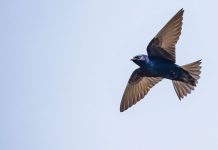In the tiny town of Allouez, just north of Calumet on the Keweenaw Peninsula, Nancy Auer has been waiting for December to arrive.
Weather permitting, the Michigan Technological University professor and 20 to 30 friends plan to bundle up and hit the road with binoculars and bird field guides. The intrepid band is one of 77 groups, and more than 1,000 Michigan birders, planning to participate in this year’s 116th annual Christmas Bird Count sponsored by the National Audubon Society.

The bird count is an early winter bird census. Volunteers count every bird they see or hear during one day in a 15-mile-diameter circle. It’s a popular activity for families, birding groups and conservationists.
“We usually go out the first Saturday in December (closest to Audubon’s Dec. 14-Jan. 5 count dates), but the last two years were pretty darn cold, and we have had years when everything was iced over,” notes Auer, coordinator for the Houghton-Hancock Christmas Bird Count, and a member of Copper Country Audubon.
“Some of us spend the whole day, from dawn to dusk, trying to outdo each other and find the most interesting bird. Then we’ll gather at a restaurant in Houghton (to compare lists). Every year someone is like, ‘Wow, you got one of those!’”
The Christmas Bird Count’s storied history dates back to 1900 when 27 counters tallied 90 species across North America, according to National Audubon. Counting birds had been proposed by an Audubon officer and ornithologist as a substitute for the traditional Christmas “Side Hunt,” a competitive event where people chose sides and went out looking for birds.
Today the count is a fun and social event, but the compiled observations provide useful scientific data about bird populations. Michigan birders observe 150 to 200 species annually, according to Jonathan Lutz, executive director for Michigan Audubon Society. The fluctuations observed over time can illustrate important changes, such as how a species’ geographic range has shifted.
“This is the longest-running citizen effort to collect science data in the world,” Lutz declares. “For some folks, that first Saturday in December is a decades-long tradition they look forward to every single year.”

Dave Dister, a botanist who coordinates the Ludington Area Christmas Bird Count, says “the fun part is trying to see rare birds, finding out what little nook or cranny they are hiding in.”
Members of his “count circle” look for birds along the Lake Michigan shoreline and along creeks and backwaters, and even at backyard bird feeders. Unusual species have turned up now and then, like harlequin ducks and even a Townsend’s solitaire, a long-tailed thrush common to western regions of North America.
In Albion, the home of Albion College, Tamara Crupi looks forward to gathering at day’s end with other counters, college faculty and community members who have spent the day combing the countryside.
“Everybody is ready to unwind, and people immediately start in with stories about the weird things that happened or the unusual bird,” notes Crupi, the Albion CBC coordinator.
“There is something seductive about seeing if you get more this year, or a new species on that day.”
To participate: michiganaudubon.org, (517) 580-7364, or email birds@michigan
audubon.org. — Howard Meyerson








Facebook Comments